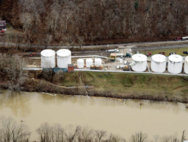

Media
Media
Share this page:
News Archive
Year
EPA Finalizes New Standards for Cancer-Causing Chemicals
April 16, 2024
Nalleli Hidalgo, a community outreach liaison with Texas Environmental Justice Advocacy Services, attended the signing last week, after meeting with Regan on his listening tour. She told ProPublica she was overwhelmed by the people missing from the room who were not alive to witness this achievement. “We have lost too many loved ones as a result of bureaucratic inertia,” she said, noting that the EPA has long been required by law to update its risk standards for these chemicals. “Our communities should not have to wait one more day for fence line monitoring to take effect.” For years, Texans like Hidalgo, living near chemical plants, have asked the agency to measure what they’re breathing in.
Read MoreNew EPA rule to reduce industrial air pollutants leaves out a majority-Black West Virginia community
April 14, 2024
Last week, Biden administration officials finalized a rule they said would significantly reduce cancer-causing air pollutants, lowering cancer risk and advancing environmental justice goals. But the move by the U.S. Environmental Protection Agency left out a Black West Virginia community yet again. While the rule will target facilities surrounding communities historically overburdened by toxic air pollution, it doesn’t cover the chemical production category that has disproportionately affected one of West Virginia’s only two majority-Black communities. “It’s actually a positive development, but it doesn’t fully address the issues in Institute,” said Maya Nye, a former Kanawha Valley resident and member of the Charleston-based People Concerned About Chemical Safety.
Read MoreFollowing a generation of grassroots advocacy, EPA takes major steps to reduce cancer-causing emissions from select chemical plants
April 9, 2024
Today, following years of advocacy from environmental justice organizations, the U.S. Environmental Protection Agency (EPA) finalized a rule to significantly reduce emissions of toxic air pollution from an estimated 200 chemical plants, in an effort to reduce elevated cancer risks experienced by fenceline communities. "It has taken nearly a whole generation of hard work to arrive in DC to make this announcement,” said Nalleli Hidalgo, Education Liaison with Texas Environmental Justice Advocacy Services (tejas), who introduced EPA Administer Michael Regan at today’s White House signing event. “As we take this moment in, we remember that we are not here as individuals but as a community standing in solidarity as we witness a key moment in rulemaking to reduce the daily harm our communities face, especially frontline communities that live directly across from HON facilities.”
Read MoreA new EPA rule is meant to prevent chemical disasters, but safety advocates say loopholes remain
April 4, 2024
Chemical safety advocates praised the EPA’s new requirements but added that the agency needs to go further, including by adding a notoriously explosive farm fertilizer – ammonium nitrate – to the list of chemicals that should require companies to develop risk management plans. Advocates also say EPA should have included more safety requirements and mandates for air monitoring at the fence lines of major facilities so nearby residents can see what chemicals are being released in real time. “We’ve needed this rule for a long time,” said Maya Nye, executive director of chemical safety advocacy coalition Coming Clean. But she added that “additional measures are needed. Read more in Oil and Gas Watch News.
Read MoreUSEPA Rolls Out Rule to Address Worst-Case Chemical Disasters, Impacting Thousands of Facilities
March 21, 2024
The rule addresses a critical vulnerability in the protection of the country's waterways and communities. Thousands of facilities that manufacture, use and store some of the most dangerous chemicals brush up against waterways or are in flood-prone areas. The new policy comes after numerous disasters affecting drinking water supplies, wildlife habitats, and environmental justice communities that experience the brunt of extreme weather supercharged by climate change. “We are thankful that this administration is finally taking long overdue action to protect workers and communities against chemical disasters. Communities of color and the poor, who are experiencing the worst of the climate crisis, are also on the front lines of the fight against policies that permit billions of pounds of pollution and concentrate the most dangerous industries in our communities” said Michele Roberts, National Co-Coordinator of the Environmental Justice Health Alliance for Chemical Policy Reform (EJHA). “While we’re glad to see this rule taking steps in the right direction, we will continue to call on EPA to truly prevent disasters by transitioning away from inherently dangerous chemicals and processes as outlined in the Louisville Charter for Safer Chemicals.”
Read MoreEPA announces stricter rules to prevent chemical incidents
March 15, 2024
On March 1, the U.S. Environmental Protection Agency (EPA) published updates to its Risk Management Plan (RMP) rule with stricter regulations for chemical accident prevention. The new rule is a result of listening sessions by the EPA in which industry, advocates, scientists and fenceline residents voiced their concerns. According to the new rule, facilities handling hazardous materials must consider safer technologies and practices, and the possibility of events caused by climate change in their emergency management plans. When a chemical incident occurs, the facility will have to undergo third-party testing to find the root cause and what could have prevented it. Any disconnection or disabling of air monitors in an emergency would be in violation of this rule and must be reported to the EPA. As a result, backup power options must be explored to prevent lack of emissions readings in events that result in the loss of power. To read a version of this story in Spanish click here. Haz clic aquí para leer este reportaje en español.
Read MoreEPA Praised for Boost to 'Life-Saving' Protections From Chemical Incidents
March 1, 2024
Hazardous chemical incidents such as explosions, fires, and toxic releases happen almost daily in the United States, often at fossil fuel facilities, and the Biden administration won praise on Friday for stepping up safeguards for impacted communities. Michele Roberts, co-coordinator of another coalition member, the Environmental Justice Health Alliance for Chemical Policy Reform, celebrated the EPA's new online database for RMP facilities, and highlighted that "communities have been asking for this information for decades. We have a right to know whether our houses, schools, and places of worship are threatened by a potential chemical disaster," she said. "We look forward to a time when a database on RMP facility and hazard information will no longer be needed because every facility will have transitioned to safe chemicals and processes, but in the meantime EPA making this critical information more accessible to communities is a huge step."
Read MoreEPA finalizes critical new chemical disaster prevention rule after years of community pressure
March 1, 2024
The U.S. Environmental Protection Agency (EPA) finalized critical updates to its Risk Management Program (RMP) rule today that will require covered facilities that use and store highly hazardous chemicals to better prevent, prepare for, and respond to disasters. The EPA also made non-classified information about RMP facilities publicly available online for the first time. Environmental health and justice advocates praised the new requirements and information access, while underscoring that EPA has the authority to take additional action outside of this rulemaking to protect communities and workers from toxic chemical harms.
Read MoreTexas has more chemical emergencies than any other state and they’re disproportionately affecting Latino communities
February 22, 2024
Texas has more chemical disasters than any other state, according to the chemical incident database from the Coalition to Prevent Chemical Disasters. A recent report created using the database suggests that a chemical incident — such as a spill, an emission leak or an explosion — occurs every other day in the U.S. These disasters affect communities in a variety of ways, including road closures, shelter in place orders, emergency room visits and, depending on exposure, increased cancer risks. Those living within a mile or less radius of a chemical facility – known as fenceline communities – are the most vulnerable. The database reported that Texas had 49 incidents in 2023, with the Houston-Galveston area accounting for 26 of them. Texas has 1,558 facilities that handle hazardous chemicals, which is also more than any other state, according to the EPA. Leer en español
Read MoreHow BPA and its evil cousins dodge meaningful regulation
January 8, 2024
BPA disrupts the proper functioning of hormones — hence the endocrine-disruptor moniker — and has been linked to cancer, diabetes, obesity, reproductive, nervous and immune system impacts and behavioral problems. It is likely partially responsible for the worldwide dramatic decline in sperm counts over the last 50 years. Surveys in the U.S. by the Can Manufacturers Association in 2020 and 2022 found that most members were no longer using epoxy resin can linings. “Food can linings are now made with enhanced performance acrylic, polyester or other non-BPA epoxy linings,” the association wrote in a letter to the Washington state Department of Ecology. But recent studies and a survey in the U.S. by the Campaign for Healthier Solutions show that progress on eliminating epoxy resin can linings is uneven. Food cans with epoxy linings are more commonly found in ethnic and discount stores serving low-income communities.
Read MoreMedia Share this page: |
What Is Environmental Justice? | Campaign for Healthier Solutions | Campaign for Healthier Solutions |
THE ENVIRONMENTAL JUSTICE HEALTH ALLIANCE IS IN STRATEGIC PARTNERSHIP WITH COMING CLEAN
info@comingcleaninc.org • (802) 251-0203 • EJHA – Coming Clean, 28 Vernon Street, Suite 434, Brattleboro, VT 05301
© 2024 Coming Clean Inc.








